| 1 | Rainforest hognose pitviper |
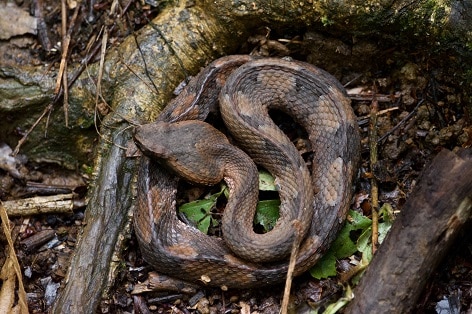
Length: 40-60cm.
This species is found in every country of Central America. It stretches from Chipas, Mexico all the way to northwest Ecuador. Along the way, it coexists with many other venomous serpents, like eyelash vipers and Mexican jumping vipers, but its standout feature is its extremely triangular head.
The rainforest hognose pitviper sticks to forests, particularly those with a thick coating of leaves and mulch. It likes to rest at the base of thick trees, waiting in ambush for lizards such as rainbow ameivas. Porthidium nastum has a moderate LD50 toxicity rating of 4.6mg, specialising in agonising pain and swelling.
Triangular heads are something of a signature of the viper family, with cobra heads being smooth and coral snakes barely even having a distinguished head. Porthidium nasutum takes it particularly far even for its family – the base of its head is over twice the width of its neck. Simply the sight of this bulky head will deter predators, and that’s before its intimidating vertical pupils come into play.
| 2 | Chinese green pitviper |
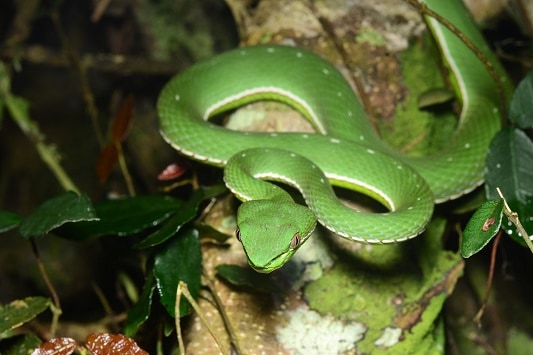
Length: maximum 75cm.
A nocturnal and dangerously venomous species. The Chinese green pitviper is semi-arboreal, splitting its time between the ground and branches 1-2 metres high. They’re perfectly comfortable in human habitation, including Taipei City in Taiwan, and are often spotted slithering down stone pavements at midnight.
As well as its triangular head, Trimeresurus stejnegeri has orange or even red eyes, another characteristic they use to effortlessly frighten people. Trimeresurus stejnegeri has a large empire. The broad swathe lies in southern China (including Shanghai), but they also inhabit northeast India and Vietnam. The highest density of sightings is in Taiwan, where the occasional yellow version has been reported. Trimeresurus stejnegeri blends effortlessly into green foliage, making it difficult to spot unless you’re staring directly ahead.
Chinese green pitvipers are a dangerous snake. A 2020 study covered 185 bite victims from Taiwan. 3 were incredibly lucky and suffered no bite symptoms. 182 experienced swelling and pain, and 53 experienced tissue necrosis. 13 experienced blood clotting difficulties, and one patient died. This snake mostly has local symptoms, but is not to be bargained with.
| 3 | Peringuey’s adder |
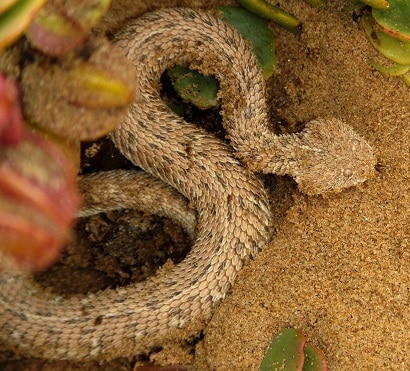
Length: 18-28cm.
One of the smallest vipers in the world, but with a bulky and triangular head. Peringuey’s adder lives in Namibian deserts and mainly preys on barking geckos, which form part of its water supply too. They possess a cytotoxic venom which causes moderate swelling. No human deaths are confirmed, partly because of their liking for remote sand dunes. To traverse these vast piles of sand, accumulated by howling winds, they’re one of the few snakes to use sidewinding locomotion.
Peringuey’s adder never sees forest or grassland. It’s purely a creature of the deserts, and only the Namib desert in Namibia’s south, a coastal desert created by anomalies of ocean currents in the south Atlantic. Peringuey’s adder also has nostrils and eyes pointing upwards, to spend long periods buried in sand dunes without worry, just like a brown watersnake in a Louisiana river.
This snake is an anomaly, as most burrowing snakes have slender heads for threading through smoothly. Their prey-capturing method might be involved – Peringuey’s adders love to burst from dunes in a shower of sand, and a triangular head might provide more propulsive, demolishing force. Peringuey’s adders produce small numbers of offspring, with 3-5 being typical. At birth, they weigh an average of just 2 grams.
| 4 | Small-eyed toad-headed pitviper |
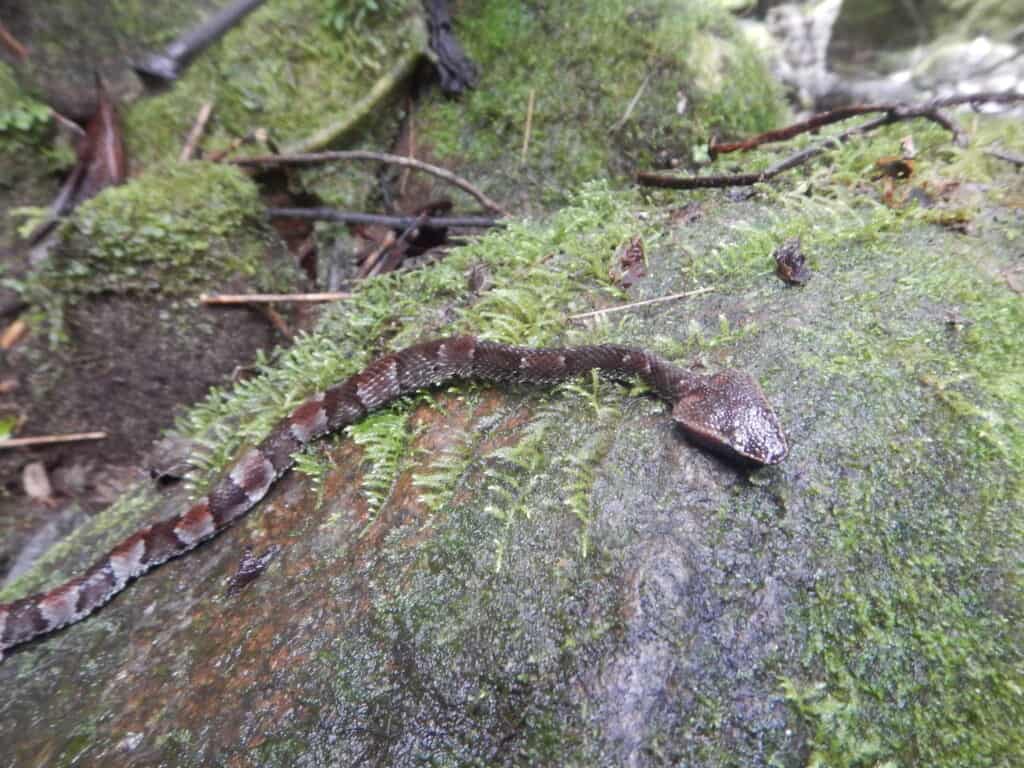
Length: 100cm.
This snake is based on the eastern slopes of the Andes, including in Ecuador, Colombia and Peru. It reaches altitudes of 2400 metres, amidst humid rainforests littered with mossy boulders amid a constant downpour. Your chances of seeing this snake are virtually nil unless you wander determinedly into its domain.
The small-eyed toad-headed pitviper might have the closest thing to a perfectly triangular snake head on the planet. They’re mainly a ground-dwelling snake, but will climb to at least 3 metres if the scents of prey draw them on. Bothrocophias microphthalmus preys on brown geckos and tree frogs, with the advantage of a powerful venom, but the disadvantage of not being able to hop.
Life as a toad-headed pitviper is something of a lottery. As youths, they possess a light-tipped tail which they use to lure prey, which mistake it for insects (known as caudal luring). In adulthood, this usually darkens to brown like their body, but a select lucky few keep it, and the luring ability. In a 2018 survey, 2 out of 9 adults still possessed this light tail.
| 5 | Ridge-nosed rattlesnake |
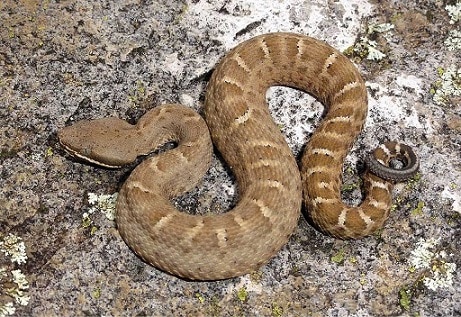
Length: 30-60cm.
One of the smaller rattlesnakes, but its head definitely isn’t smaller. Whether they need it to contain a huge brain with secret intelligence, we don’t know, but the ridge-nosed rattlesnake’s head is thick and triangular. Crotalus willardi lives in Arizona and northern Mexico, sticking to sky islands in mountain ranges. It particularly loves well vegetated canyons, with an abundance of rock cracks to hide in.
This rattlesnake doesn’t have a confirmed death to its name. It’s just a small snake and its venom injection total is correspondingly small. The worst its venom has caused on record is painful swelling in a 57 year old man, which subsided after 3 days. Ridge-nosed rattlesnakes default to fleeing when approached by humans with cameras, although they could probably wreak havoc by swinging their head like a battering ram if they realised it. This is a distinct rattlesnake, with a reddish colour overlaid with white slashing stripes. On their face, the white coalesces into a clear line which runs below their eye.
Crotalus willardi is a rare snake to look after its young. Scientists watched as a mother rattlesnake in Arizona stayed within several metres of her vulnerable hatchlings. When she retreated into a dark crack, the hatchlings obediently followed her. A nearby male rattlesnake flecked its tongue, hoping to capture the females’ attention, but failed.
| 6 | Green bush viper |
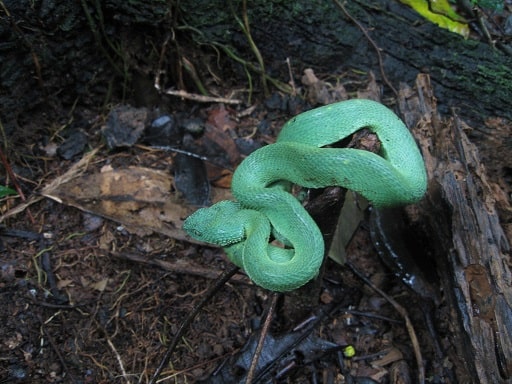
Length: 50cm, maximum 70cm.
A venomous snake of West African forests, particularly Ivory Coast and Ghana. They particularly like branches 1-2 metres above ground, which fortunately for human intruders, is roughly eye level.
If you never visit the forests of West Africa, then you’ll never meet the green bush viper (Atheris chlorechis), but if you do then watch your step. This species lacks any dedicated venom, and its venom causes brutal coagulopathy, AKA the disabling of blood clotting. In 2006 a 26 year old Danish reptile enthusiast was bitten on the forefinger while handling one he kept as a pet. This guy had also been bitten by a Gila monster the previous year. In the first 6 hours in the ICU, he lost 6 litres of blood, while his kidney function was severely impaired. Somehow, he survived.
Atheris chlorechis’ appearance is a double-edged sword. In grass and foliage, it has incredible camouflage, while on boulders and logs, it stands out like a sore thumb (see above). The green spreads to its eyes, while the pupils are sharply vertical. Atheris chlorechis have rough scales, but nothing in comparison to their hairy bush viper relative.
| 7 | Central Asian pitviper |
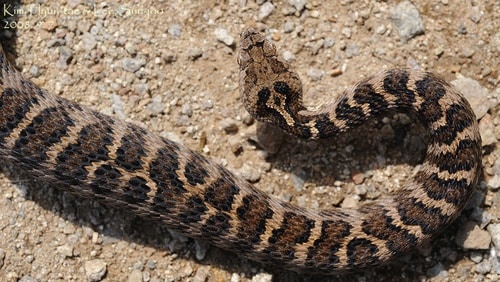
Length: 50-70cm.
A cousin of the notorious Japanese mamushi. This is a widespread species which lives from Iran to China to South Korea, and sticks to open areas above 400 metres, with minimal forest cover and wide sweeping grassy plains with rocks dotted around.
Its venom contains haemorrhagins, but is rich in unique neurotoxins called gintoxins. A 2015 study found that these were similar in structure to the crotoxins of American rattlesnakes. Consequently, Gloydius intermedius is theorised to be the ancestor of those notorious American bogeymen, slithering across the Alaskan land bridge and morphing into something different, eventually growing a rattle.
Gloydius intermedius never charges humans down, preferring to stay still much of the time. They like to rest amidst rocks and in piles of leaves, waiting for their prey to come to them. Central Asian pitvipers primarily eat mammals. With such a huge triangular head, you’d think they could gulp down huge prey, but they stick to small scurrying fare like the house mouse and royal vole (Craseomys regulus).
| 8 | Egyptian saw-scaled viper |
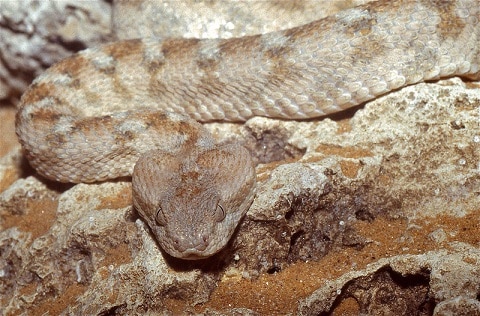
Length: 30-60cm, maximum 85cm.
The pyramid saw-scaled viper inhabits northeastern Africa, including the dry, dusty countries of Egypt, Ethiopia, Eritrea and Somalia. It’s a common snake which deals out many snakebites to local Africans per year.
Echis pyramidum has a very thin neck, but they avoid embarrassment by having an extremely bulky, triangular head. This is reminiscent of most of its viper relatives, yet expanded to a whole new level. Its eyes are beige, slighter darker than its sandy scales, and bulge out of its head sideways.
An angry pyramid viper has a classic C-coil posture. This snake doesn’t appear in true deserts, but semi-deserts, rocky plains and dry savannah. You can find pyramid vipers at up to 1200 metres above sea level – flee higher and you’ll be perfectly safe (until you have to come down again).
Rather than one or two dotted around a sweeping desert, Pyramid vipers are abundant in regions where they live. One study analysed snakebites in northwest Ethiopia from 2015 to 2019, and found that Echis pyramidum caused the most annual snakebites alongside puff adders.
| 9 | Jararacussu |
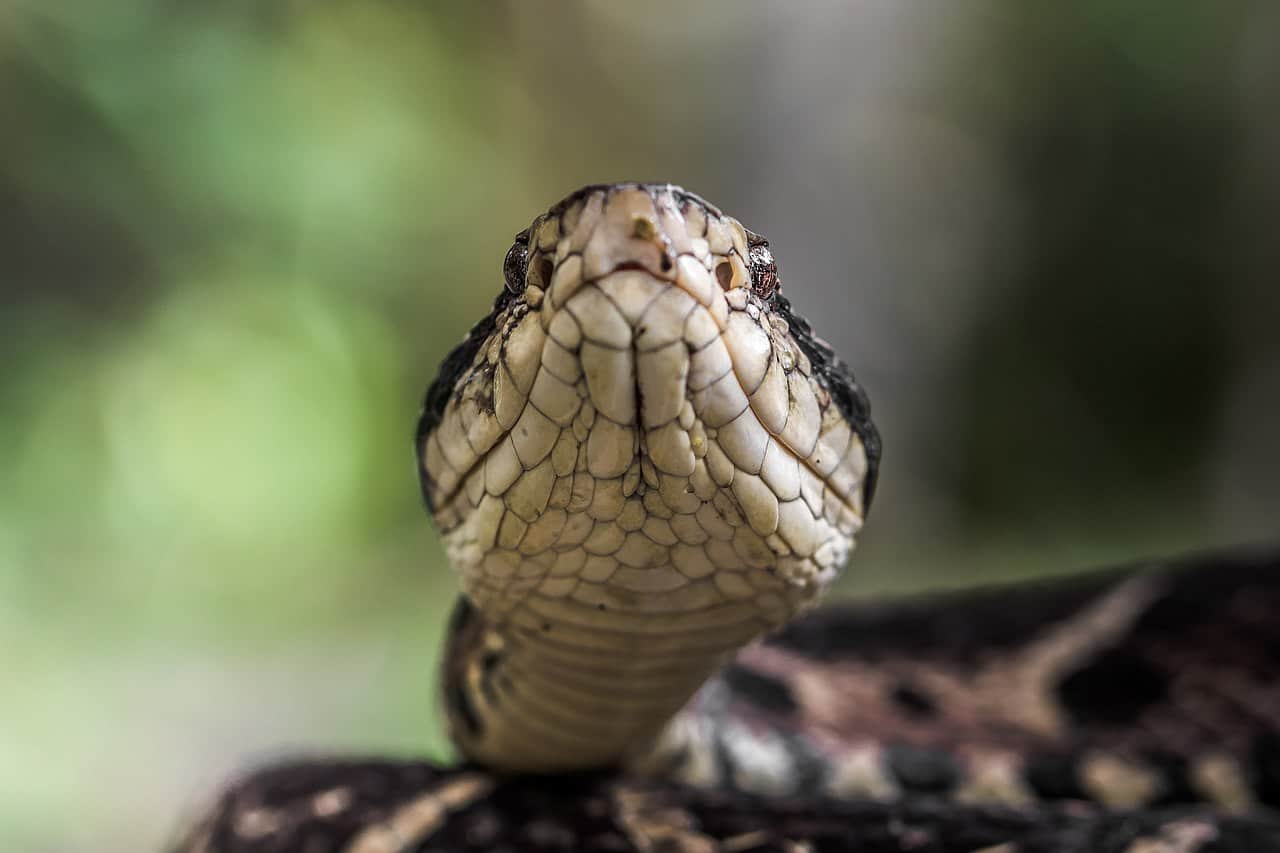
Length: up to 2 metres in females, 1 metre in males.
This species lives in southern and eastern Brazil, particularly in tangled forests along the Atlantic coast. Its venom is a swirling soup of toxins, which mainly focusses on the kidneys, skipping the lungs. A bite from a jararacussu can leave a victim dependent on haemodialysis for the rest of his life. Luckily, they rarely stray to more open areas like grassland.
As mentioned above, this species has an enormous size disparity between the genders. Jararacussus also have a vivid black-cream pattern, contrasting sharply. Their pupils are vertical, and the forests they inhabit are probably full of chirping and yellow eyes watching as you try not to be bitten. The triangular head is the last ingredient to this recipe of fear.
According to a survey from 1906 to 1945, jararacussus caused 657 snakebites of 6601 in Brazil, but just 11 led to death. They’re not especially fast-moving, and may even play dead rather than attack. Another consolation is that antivenom is readily available and highly effective.
| 10 | Mangrove pitviper |
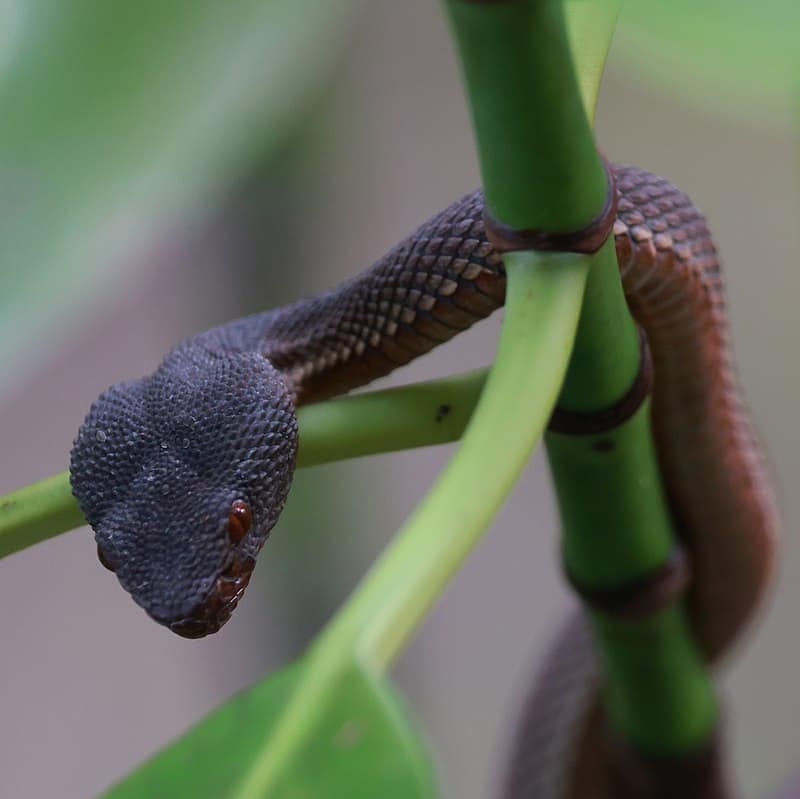
Length: 60-80cm.
Mangrove pitvipers (Trimeresurus purpureomaculatus) range from Thailand, through Malaysia and Singapore to Indonesia. Their favourite place of all is branches on the edges of water bodies, particularly swamps and mangroves. The Sungei Buloh wetland reserve in Singapore is one of their ultimate hotspots.
Mangrove pitvipers like to rest on branches moving nothing except their forked tongue, which they wave up and down like they’ve waving at people. Don’t bother waving back – they’re really probing the air for reptile and frog scents, which form most of their prey. They’re confirmed to eat other snakes, including the crab-eating snake (Fordonia leucobalia). Mangrove pitvipers are motionless much of the day, yet easily agitated and will spring at you without warning.
This is a rough snake in every way – they have keeled scales like overlapping leaves, and touching them will land you in hospital with a pair of fang marks. A bite is usually non-fatal, causing intense pain and a dose of haemorrhaging. While there’s no specific antivenom for Trimeresurus purpureomaculatus, the family-wide antivenom used on white-lipped pitvipers works well.
